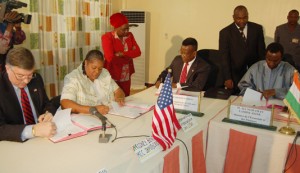Helping Make Education a Reality for Girls in Niger
Friday, March 28th, 2008Niger is one of the poorest countries in the world, with a per capita income of $260 a person, and a troublesome ranking of just three from the bottom in the UN’s Human Development Index (174 out of 177). I’ve just returned from a trip to the country where I represented MCC during the signing of a $23 million threshold agreement. The bulk of the threshold program—$18 million or so—is to help Niger improve its low rate of girls’ primary school completion. Niger is in the bottom 5 percentile of low income countries and has a bright red score on MCC’s index for this category. Red, in terms of MCC’s “scorecards” of performance, is not good.
The threshold program has been put together with a notion of helping up to 200 schools become more “girl-friendly.” It’s one drop in an enormous bucket of educational needs, but the Minister of Education, Monsieur Samba Mamadou, shared with me his excitement about the threshold program. The morning after the signing ceremony, he joined me, the US Ambassador to Niger Bernadette Allen, local USAID representative Mark Wentling, and USAID regional Mission Director Henderson Patrick, who flew up from Accra for the occasion. We set off in a dusty caravan of vehicles for the province of Tillaberi to visit some of these schools and talk to our local partners about their needs and challenges.
We bounced for dozens of kilometers along a mix of paved and sandy roads—a reminder of the overwhelming needs of so many countries where we work. The driver of our car had to flip on the wipers constantly to blow away the dust on the windshield. I asked the Minister of Education about Niger’s education needs during the trip. “Everything” was the short answer to the question, with the most critical component being trained teachers, followed by school buildings, notebooks for students (“cahiers”), textbooks, blackboards, desks—you name it. We talked at length about the discrepancy between boys’ and girls’ enrollment rates. He cited the reasons as cultural, social, and economic. Many parents need help in hauling water for the families’ use during the day. Other daughters are married when they’re 13 or 14. The minister made it clear that he, like so many others, understands full well the importance of having girls remain in schools and wants to help make it a reality.
After we drove several dozen more kilometers on the western side of the Niger River, we arrived at the first school. The school buildings are one story tall, built of tan bricks. There was no electricity that I could see, but there were dozens and dozens of people, adults, teachers, local officials and three Peace Corps volunteers at this first site. The school rooms I saw were simple, sometimes with a blackboard, but always packed with kids. In one school room, they’re wearing paper hats with “Niger-MCC-USA” written around the bands. They sang and clapped as we ducked to enter the school room and wish them well. On the black board, in one corner, someone had written the number of garcons and jeunne filles that were in attendance that day. That particular day, in that classroom, the girls outnumbered the boys. This was great news. The governor assured me that the word was getting out to the local officials, tribal leaders and families about the importance of encouraging their daughters to come to school. The need for new classrooms to accommodate the students was evidenced by a lean-to, with a primitive stick roof, that serves as a classroom for 30 or more children, who appeared to be about five or six years-old. There were no chairs and no desks. The head of the school talked to us about the need for latrines, and for places to feed the children. A “cafeteria” would probably be too grand a name for what will likely be a new room for this purpose, possibly with a stove and water. I asked some Peace Corps volunteers, who are working in schools further away from this one, what they needed. “Everything” again was the simple answer. MCC’s Niger Threshold Program certainly isn’t everything, but it is at least a start.




